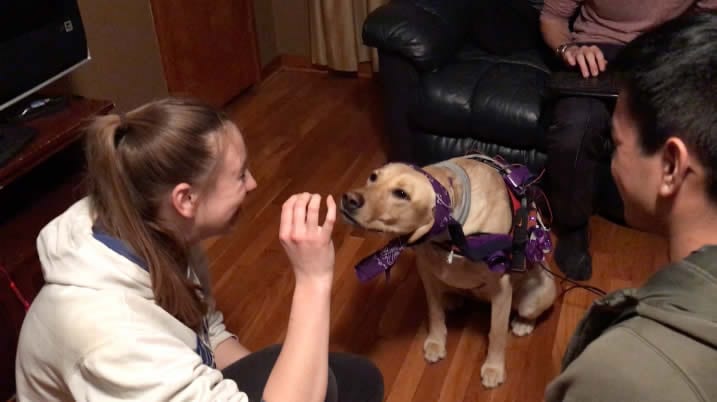University of Illinois Students Are Helping Dogs Talk

University of Illinois Students Are Helping Dogs Talk
By Ben Chapman
benbart.chapman@gmail.com
The project is called “Dug the Dog IRL” (read: Dug the Dog In Real Life), and it’s a wondrous mix of nerdy, fascinating, and adorable. A prototype of the technology will be on exhibit at the University of Illinois Engineering Open House in Everitt Laboratory.
Bliss Chapman of Mahomet is the Signal Processing Team Lead in the project. He believes that the technology could be a valuable step forward in expanding our understanding of animal behavior.
The team says the concept is based on the talking dog collars featured in the Pixar movie, “Up.”
Instead of Dug, though, the they are testing the prototype on an exceptionally well-trained yellow lab named “Alma,” after the famous Alma Mater statue on the University of Illinois campus.
Alma seeing a treat.
Technical explanations of the project are provided in a “Project Dug” article that the team has published on GitHub.
Team members Bliss Chapman, Amanda Maher, and Matthew De Venecia explained how the collar works.
The concept is simple.
Information in the form of electrical signals from Alma’s brain is picked up by electrodes. Circuitry amplifies the information and miniature computers on Alma’s back correlate it to a specific stimulus that she is experiencing.
If a familiar pattern is recognized, a speaker plays a recording that is associated with the emotions the dog is likely experiencing.
In this case, the group has chosen the stimulus of offering Alma a treat.
When Alma sees the treat, the electrodes pick up a signal of excitement and the speaker plays the words, “Oh! Treat! Treat! Yes, I want the treat. I do so definitely want the treat. I would be very happy if I were to have the treat!”
Amanda Maher, a junior in Mechanical Engineering, describes the project as “listening in” on signals from Alma’s brain.
One of the difficulties Maher says the team has faced is making sense of the raw electrical data from the custom 3D printed electrodes.
Most electrodes by default have a “pre-program” that is already attached to them when they are purchased that makes their usage a bit simpler. With the custom electrodes, no pre-program exists. This added an extra level of difficulty for the team.
Matthew De Venecia, a senior in Bioengineering, and Chapman, senior in Statistics and Computer Science, both say that shielding the wires from electrical interference was an unexpectedly important step.
The signals that the electrodes receive from Alma’s brain are very weak.
The cables that travel from Alma’s head to the high-tech harness on her back (where computing takes place) can be bombarded with outside electrical activity. Even small disruptions, when amplified, can muddle the signals from Alma’s brain.
The team had to take steps to braid the wires and coat them in nickel to reduce this interference.
Overall, the Dug the Dog IRL group estimates that, if they hadn’t had any of the supplies previously, their prototype would cost about $180 in materials.
Matthew De Venecia soldering circuitry
De Venecia sees a future for the technology for humans.
He says that because the technology is able to take brain inputs and create an event, it could eventually be used to make highly advanced prosthetics.
Taking this to an extended degree, he says it could allow people to accomplish complex tasks like typing or driving a car with just their thoughts.
De Venecia also anticipates veterinary applications.
He says that currently, “A vet can’t just ask a dog, ‘hey, where does it hurt?’” With this technology, better vet-animal communication is possible.
Chapman says the tech could one day “unlock high bandwidth communication with other species.” He believes this would give humans an entirely new lens to view the world, as it will offer a glimpse into the minds of animals.
He wrote in an email, “We often assume what we see is how the world is, but science continually shows us how wrong that assumption is. Other species have entirely different sensory systems and often see the world much differently than we do. I, for one, would love to hear more about their perspective.”
The prototype will be on display at Engineering Open House from 9AM-4PM on Friday and Saturday (March 8th and 9th). It will be located in the Atrium of Everitt Laboratory on the University of Illinois campus.
Alma, the dog, could not be reached for comment on this story.
The full members of the “Dug the Dog IRL” team are: Jessica Austriaco, Christine Lannon, Suva Laxminarayanan, Amanda Maher, James Soole, Kyla Swain, Bliss Chapman, and Matthew De Venecia. All the photos in this story were provided generously by their team.




